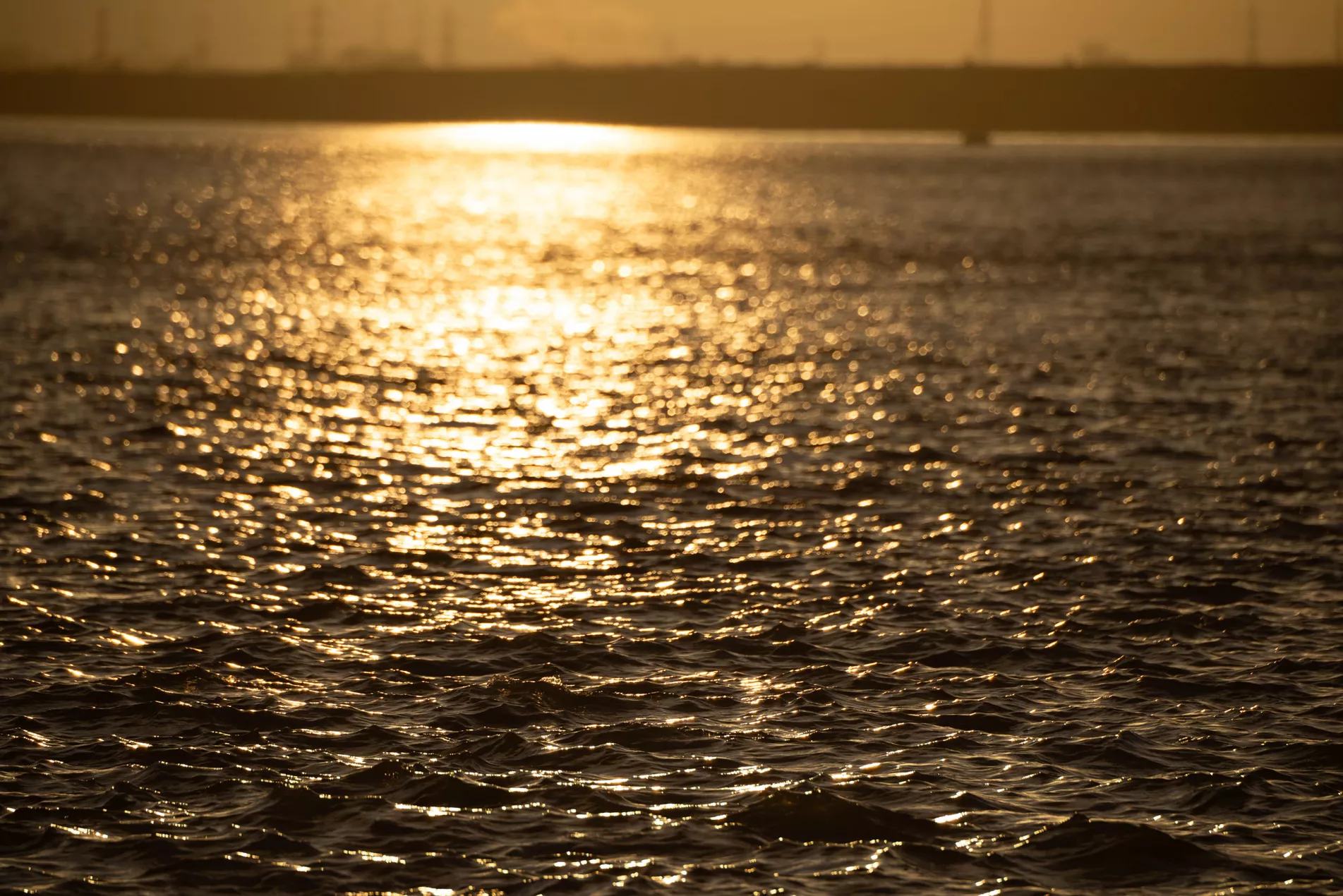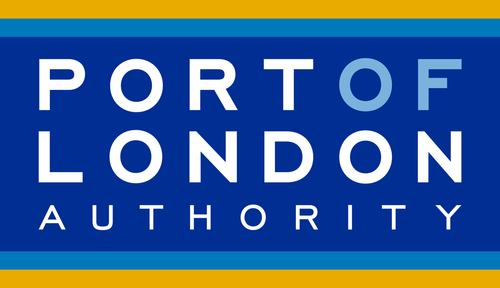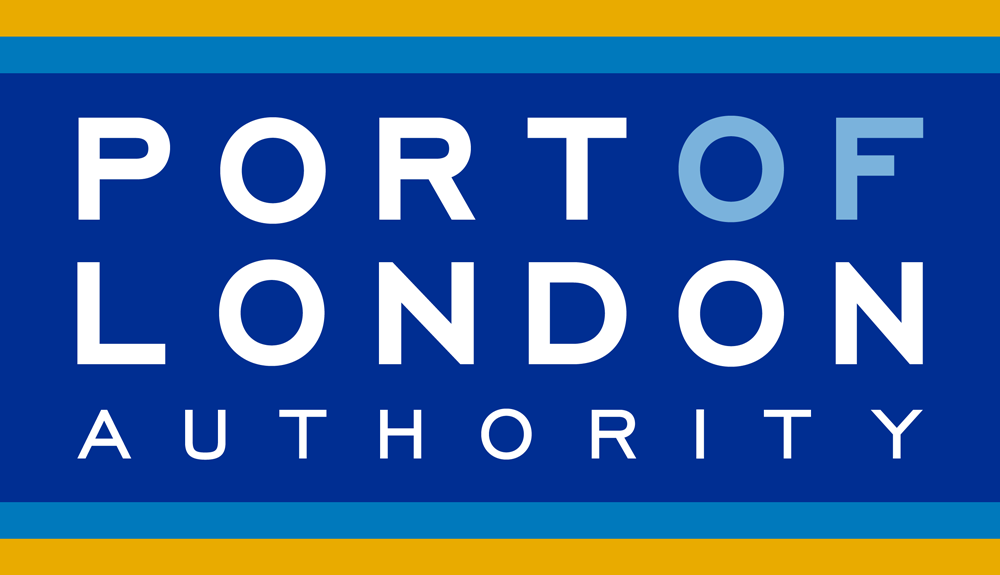Live Tides
NOTICES TO MARINERS
Charts & Surveys
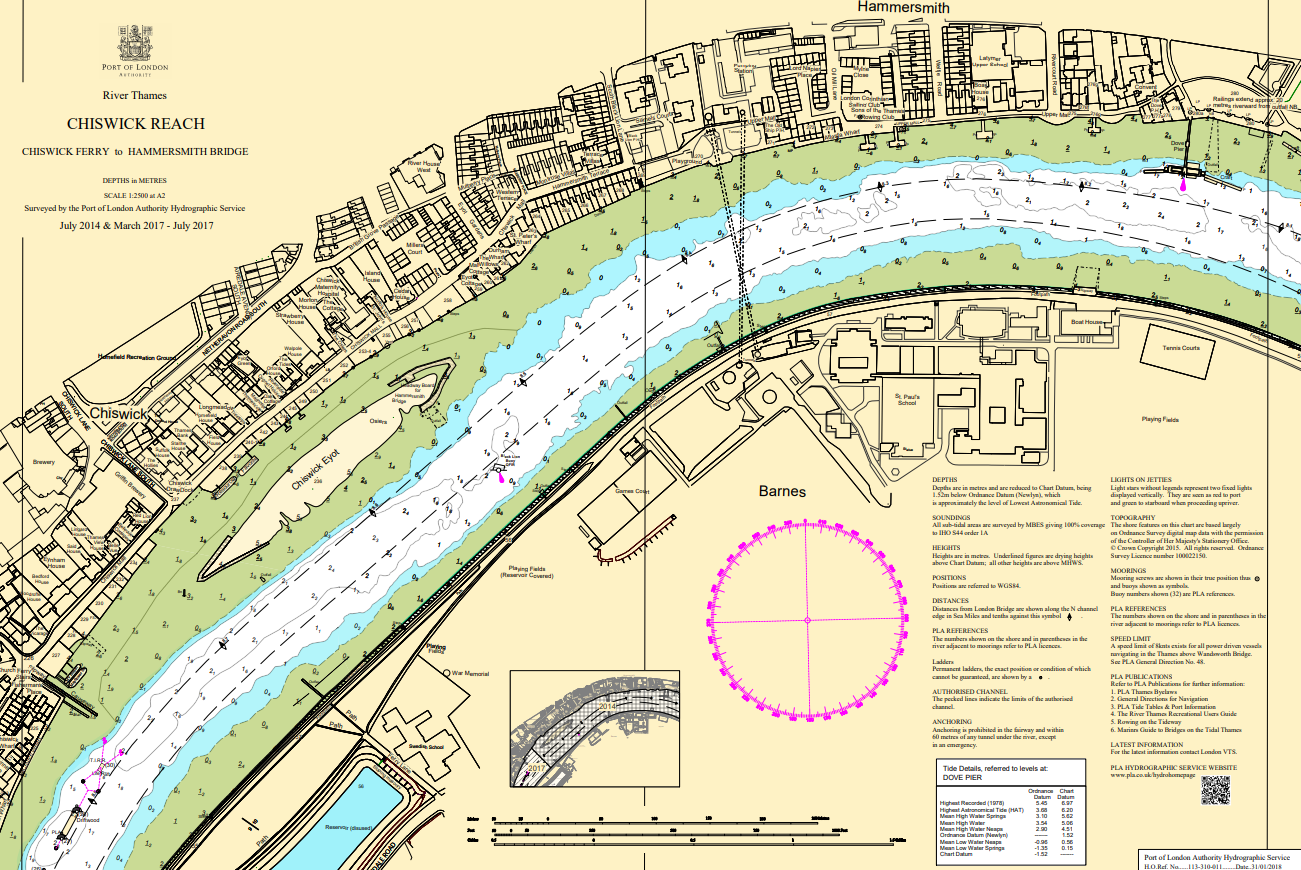
Incident reporting
Life-threatening emergencies on the river:
Call 999 and ask for the Coastguard
For near miss, safety observations and incident reporting click below
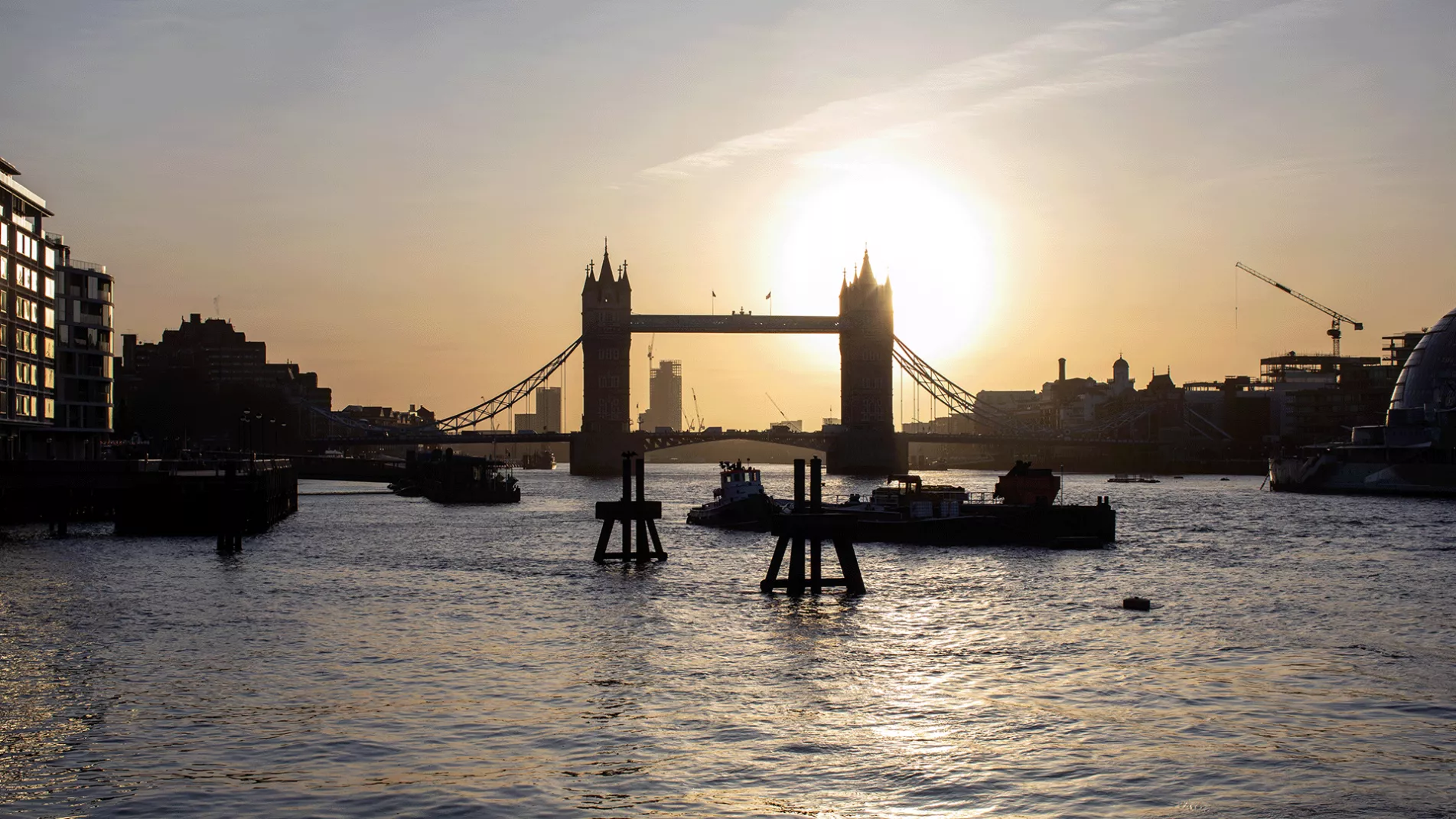
Thames bridges
28 of the bridges across the tidal Thames
Albert Bridge
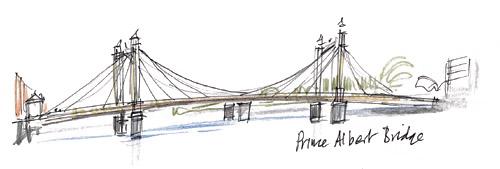
Designed by Roland Mason Ordish and built in 1873, this suspension bridge was named after Prince Albert, the husband of Queen Victoria.
It was originally a toll bridge and, although tolls were abolished in 1879, the toll booths still remain. Nowadays, the bridge is not strong enough to carry modern traffic and a weight limit of two tons was introduced in 1973. Of interest are the notices on the bridge which instruct marching troops to break step when crossing it!
The Albert bridge is at its most beautiful at night when it is illuminated by thousands of electric light bulbs.
Barnes Bridge

In 1847 the Windsor, Staines and South-Western Railway was given permission to build a line from Barnes to Feltham. The bridge to carry this line across the Thames was designed by Joseph Locke and Thomas Brassey and opened in 1849. The line was popular for passengers and freight, avoiding as it did the busy and congested route through Richmond.
The bridge was also very popular as a vantage point from which to see the closing stages of the University Boat Race - special trains were laid on to allow spectators to enjoy the view from the comfort of a railway carriage.
The bridge was strengthened to cope with increasing traffic in 1891-95, at which time the footbridge was added. This was made especially strong to support the crowds that traditionally gathered for the Boat Race. However, the footbridge is now closed during the race.
Battersea / Wandsworth Railway Bridge
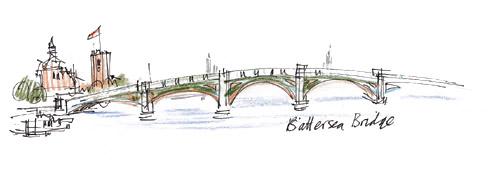
This railway bridge was opened in 1863 as part of the West London Extension Railway. This connected lines running from Waterloo and Victoria with those from Euston and Paddington and it carried both standard and the broad gauge railway tracks needed for Great Western Railway stock.
The bridge still carries the only north-south route through London but is now subject to a speed limit of 15 mph.
Blackfriars Bridge
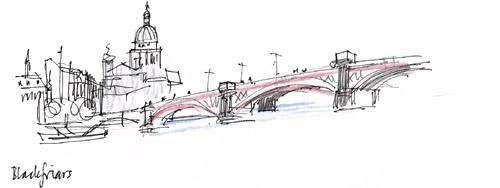
This bridge was designed by Joseph Cubbit and opened by Queen Victoria in 1869.
It replaced an earlier stone structure and features stone pillars shaped like pulpits between iron arches. These pillars were designed to resemble the interior of a church to commemorate the 13th century Dominican monastery that gave its name to Blackfriars.
Cannon Street Railway Bridge
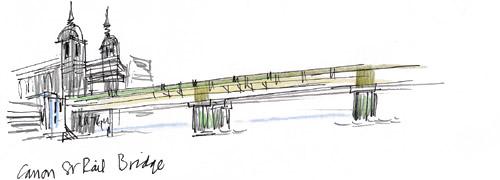
This bridge was designed by Sir John Hawkshaw for the South Eastern Railway and opened for traffic in 1866. It originally had two footpaths. One was reserved for railway employees but the other was open to the general public on payment of a toll. The tolls were abolished in 1877.
The bridge was widened and strengthened in 1898 at which time the footpaths were removed. Since then the bridge has been rebuilt twice, the latest version being constructed by British Railways in 1981.
Chelsea Bridge
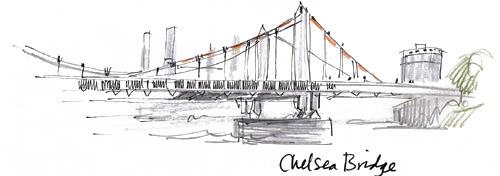
The first Chelsea bridge was designed by Thomas Page and opened in 1858. Like the present bridge, this was a suspension bridge and was described at the time as the most beautiful of the bridges that crossed the Thames. It gave access to Battersea Park, which had been laid out just before the bridge was built. Tolls were payable, and this led to complaints that "Government gave a park to the people but placed a toll-bar at the gate to keep them out". The tolls were abolished in 1879.
The old bridge was demolished in 1935 and the new suspension bridge was provided with much stronger foundations to cope with increasing traffic levels.
Chiswick Bridge

This bridge formed part of a major road improvement scheme and was designed by Sir Herbert Baker.
It is virtually on the finishing line of the University Boat Race and was one of three Thames bridges opened by the Prince of Wales on the same day in 1933.
Grosvenor Railway Bridge
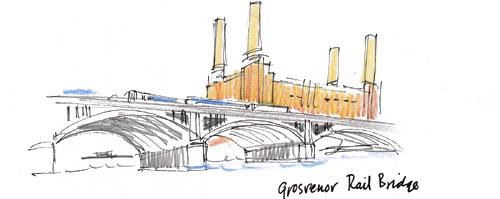
This bridge is also known as the Victoria Bridge and the first railway bridge to cross the Thames into central London. It was designed by Sir John Fowler for the London, Brighton and South Coast Railway and opened in 1860.
A second bridge to match the existing structure was designed by Sir Charles Fox for the London, Chatham and Dover Railway. This was built alongside the existing bridge in 1866.
A third bridge was built in 1907 to increase the number of tracks into Victoria Station up to ten.
All three bridges were replaced between 1963 and 1967 and there are now in effect ten separate bridges each carrying one railway line.
Hammersmith Bridge

The first bridge in this location was designed by William Clarke and opened in 1827. It was the first suspension bridge to span the Thames.
The current structure, also a suspension bridge, was designed by Sir Joseph Bazalgette and opened in 1887. Of all the London bridges, this one offers the least headroom over the River. It is a favourite vantage point from which to watch the University Boat Race.
Hammersmith is one of the most attractive of London's bridges. This is especially true at night after a new lighting scheme was installed in 2000.
The bridge was closed indefinitely to all motor traffic in April 2019 after cracks were discovered in its pedestals.
Hungerford Bridge and Golden Jubilee Bridges
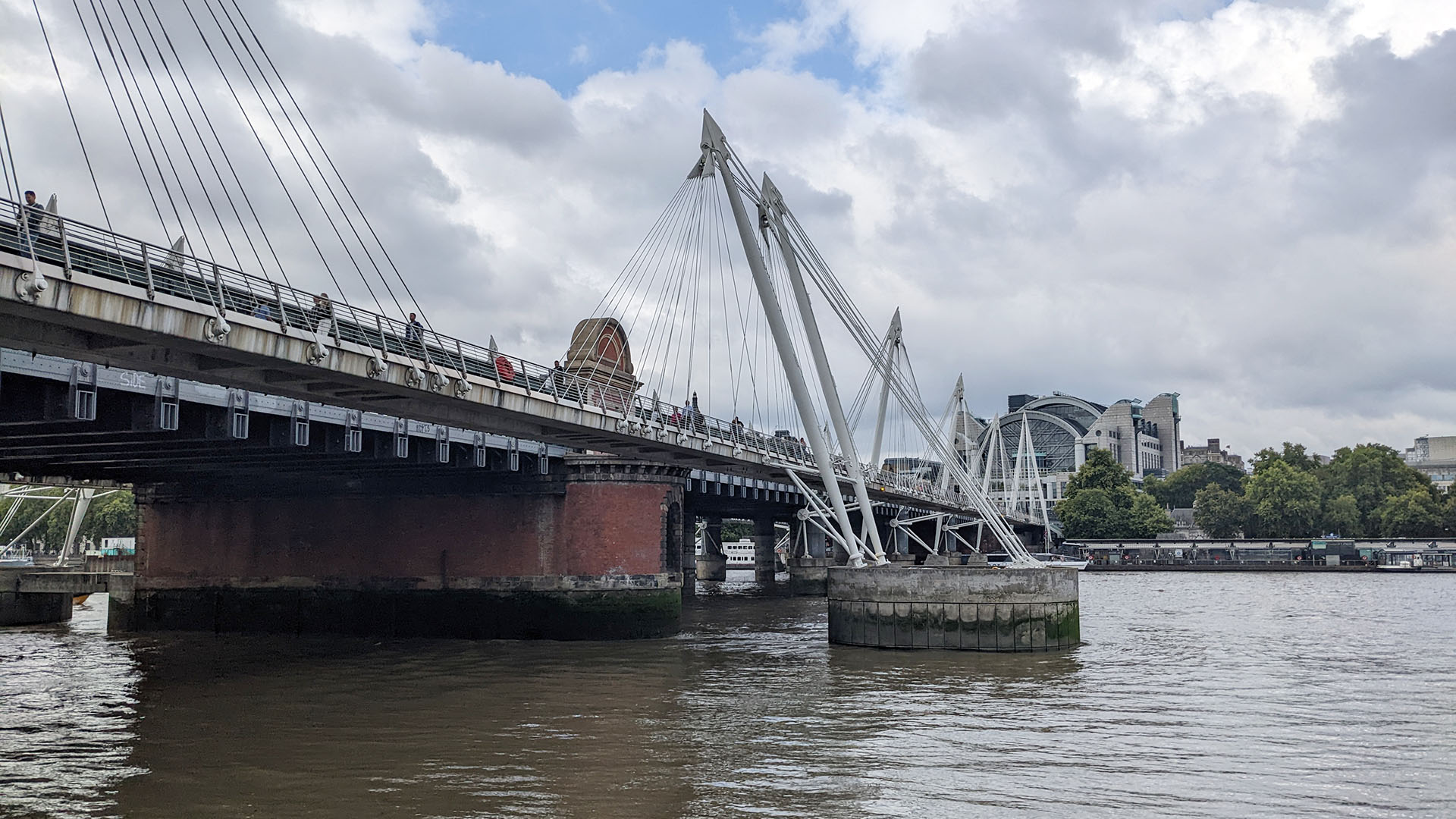
These bridges take their name from Hungerford Market which was situated on the site now occupied by Charing Cross Station.
The first bridge at this location was designed by Isambard Kingdom Brunel and opened in 1845 to provide pedestrian access to the Market. The bridge was purchased in 1859 by the South Eastern Railway so it could extend the line from London Bridge to the proposed new Charing Cross Station. The chains and other suspension parts of Brunel's Thames bridge were used to finish his other bridge across the Avon Gorge in Bristol in memory of the famous engineer who had recently died.
The new railway bridge, which utilised Brunel's original foundations and piers, was completed in 1864 and included two toll footpaths which the Railway Company was obliged to maintain. The tolls were abolished in 1878 and one of the footpaths was replaced by track in 1882. However, the bridge remained as the only London crossing to take both rail and pedestrian traffic.
The single footpath was replaced by two new suspension footbridges, designed by Lifshutz Davidson, and completed in 2002. They were named the Golden Jubilee Bridges, in honour of the Golden Jubilee of Queen Elizabeth II.
Kew Bridge
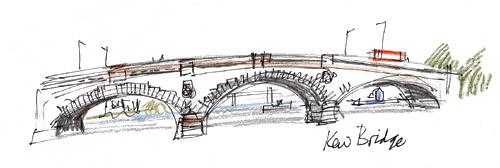
The first bridge at this location was built of wood in 1759 and replaced a horse powered ferry. The power of the currents in the Thames started to damage the wooden piers so the bridge was replaced by a stone structure designed by James Paine thirty years later in 1789. The new bridge was opened by King George III.
In 1873 ownership of the bridge passed to the Metropolitan Board of Works and tolls were abolished. The bridge was later transferred to the Middlesex and Surrey County Councils.
The present bridge, the third to occupy this site, was designed by Sir John Wolfe-Barry and CA Breton and opened by King Edward VII in 1903. The bridge was re-named the King Edward VII Bridge to commemorate this, but this name proved unpopular and it reverted to Kew Bridge a few years later.
Kew Railway Bridge
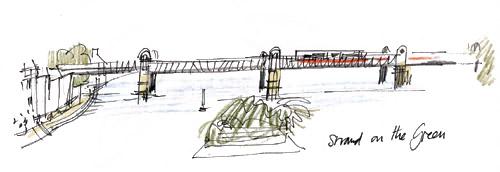
This bridge was built by the London and South Western Railway Company to extend the line from South Acton Junction to Richmond.
It was designed by WR Galbraith and opened in 1869.
Lambeth Bridge
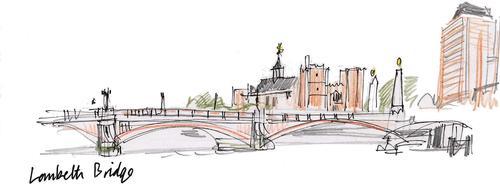
The present bridge was designed by George Humphreys and opened by King George V and Queen Mary in 1932. This replaced an earlier iron suspension bridge designed by PW Barlow which was opened in 1862. Severe problems with rust to the iron structure resulted in the bridge becoming unsafe after only forty years or so.
The pineapples on top of the obelisks at each end of the bridge commemorate John Tradescant, who was gardener to Charles I. He was the first man to successfully grow a pineapple in England.
London Bridge
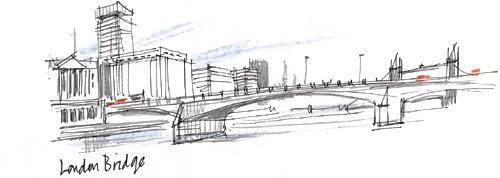
Until 1750, when Westminster Bridge was built, this was London's only bridge across the Thames. The first bridge was built by the Romans in about AD 50 and was succeeded by a timber bridge built by the Saxons. The bridge was rebuilt in wood several times until the last timber bridge was built in 1163.
Work started on a new stone bridge in 1176 and was completed in 1209. This was the famous old London Bridge, complete with shops, a chapel and houses. By the middle of the 18th century a large number of the houses were occupied by pin and needle makers, whose pins can still be found on the foreshore.
A new stone bridge, designed by John Rennie, was opened in 1831 by King William IV and Queen Adelaide. This bridge was in use for 140 years until it became too weak to cope with modern traffic and had to be replaced. The old bridge is now sited in Lake Havasu City, Arizona, having been removed brick by brick in 1973.
The present bridge was built by Harold Knox King and was opened by Queen Elizabeth II in 1973.
Millennium Bridge

Built by Southwark Council in association with the Millennium Bridge Trust and the Corporation of London, this was the first new footbridge to be constructed over the Thames for 100 years.
The bridge was designed by Foster and Partners, Ove Arup and Partners and Sir Anthony Caro and is 370 metres long, four metres wide and 9.5 metres above the river.
It was inspected and dedicated by Queen Elizabeth II on 9 May 2001 and opened on 10 June 2001.
The bridge was closed soon after to allow engineers to investigate a disturbing swaying effect that occurred when a large number of people crossed at the same time. After installation of a new damping system, the bridge was re-opened in 2002.
Putney Bridge
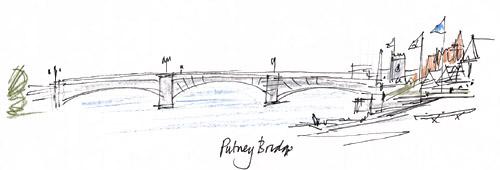
This bridge marks the start of the annual Oxford and Cambridge Boat Race.
The first bridge was of timber construction and opened in 1729. Tolls were payable but initially people were reluctant to pay these - they did not pay when they went over London Bridge, why should they pay at Putney? Two toll collectors were stationed at each end of the bridge and issued with staves which were occasionally used to persuade the public to pay. In 1730, bells were hung on the tops of the toll houses so that collectors could go to the assistance of their colleagues if they were in trouble.
The present stone bridge was designed by Sir Joseph Bazalgette for the Metropolitan Board of Works and was opened by the Prince and Princess of Wales in 1886.
Putney Railway Bridge
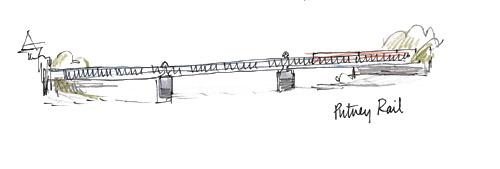
Designed by WH Thomas and William Jacomb, this bridge opened in 1889 for the London and South West Railway.
The bridge is now used by the London Underground District Line.
Queen Elizabeth II Bridge (QEII)
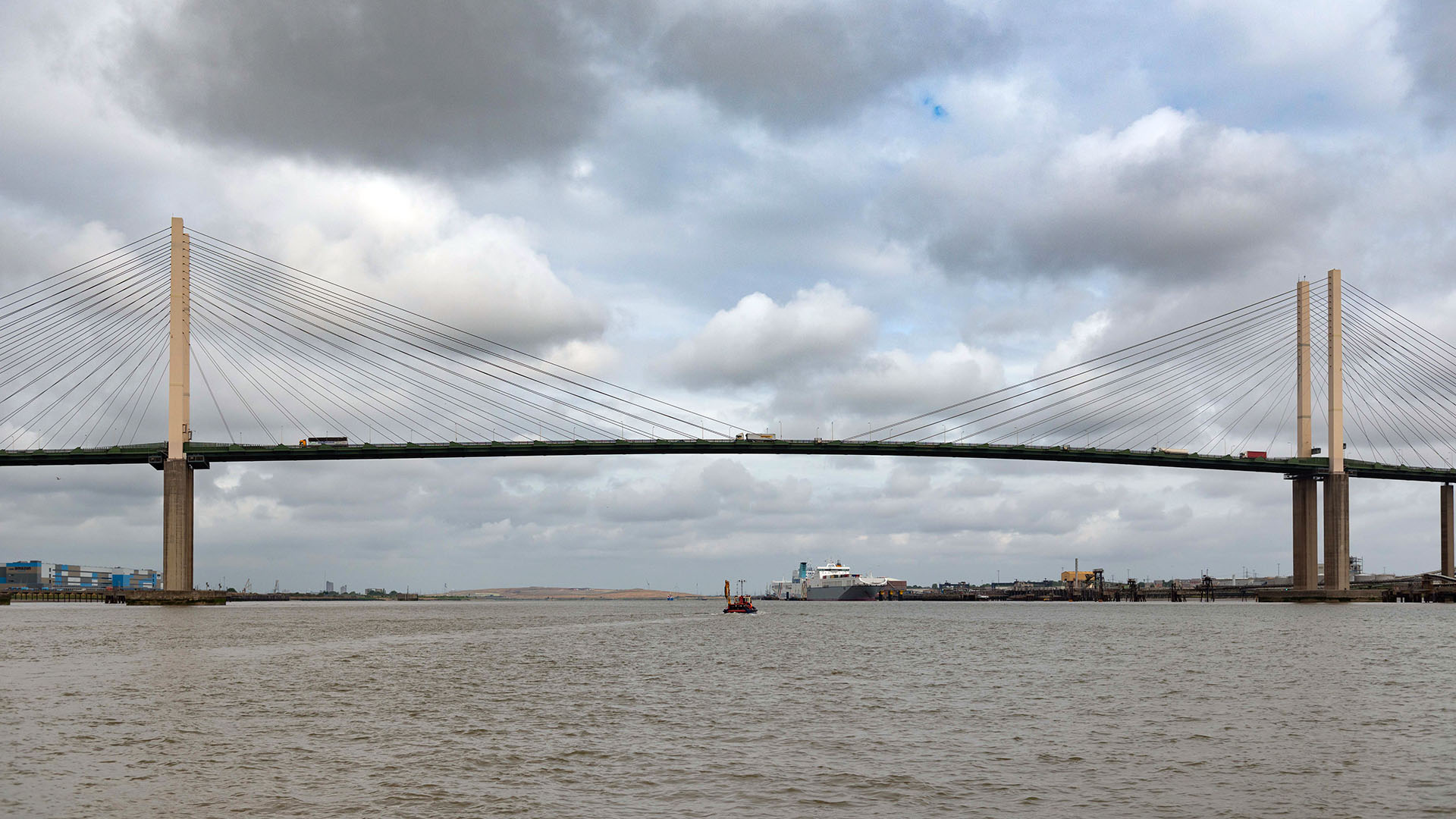
The Queen Elizabeth II Bridge is situated some 20 miles east of London, between Dartford in Kent and Thurrock in Essex. It carries the M25 traffic across the river from Essex to Kent.
The need for a new crossing at this point was identified in the 1980's as sections of the M25, the new orbital motorway around London, were opened. It was recognised that the existing tunnels, which now carry M25 traffic from Kent to Essex, would be seriously overloaded once the motorway was finished.
Work on the bridge started in August 1988 and it was opened by Queen Elizabeth II in October 1991. At this time it was the largest cable-supported bridge in Europe and cost £86 million to build.
Traffic volumes have grown by 75% since the bridge was opened and it is now used by approximately 50 million vehicles every year.
Richmond Bridge

Built in 1777 by James Paine and Kenton Couse, this is the oldest Thames bridge still in use. Before the bridge was built, a ferry operated by the Crown occupied this site and was used extensively by King Henry VIII and his daughters, who spent much of their time at Richmond Palace.
The bridge was transferred to Middlesex and Surrey County Councils in 1927 and was widened between 1937-39. Great care was taken to retain the original appearance and each stone was removed, numbered and replaced after the foundations had been extended.
Richmond Lock

The Grade II* listed structure is owned and operated by the Port of London Authority.
Permission was granted in 1890 to build a half-lock and weir downstream of Richmond Bridge. This followed many years of petitioning since the old London Bridge was demolished in 1862. The effect of the removal of the palisades that protected London Bridge was to cause the tides to rise and fall more rapidly than before. This effect, combined with increased dredging activities in the lower reaches of the Thames, resulted in the river at Richmond and Twickenham becoming little more than a trickle between wide mud banks for long periods of time.
A barge lock was built on the Surrey side at Richmond and this was joined by a weir to three roller slipways for small boats on the Middlesex side. The weir was opened and closed twice a day to hold water back at low tide. A superstructure was needed to house the weir mechanisms and this was constructed to form two footbridges. These were opened by the Duke and Duchess of York in 1894.
Richmond Railway Bridge
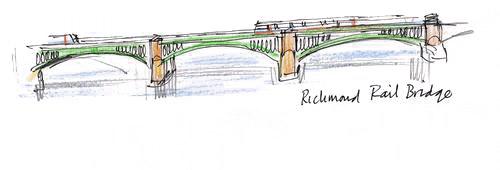
A new six mile line to connect Richmond with Waterloo via Clapham Junction was built by the Richmond Company in 1846.
In 1847 the Staines and South Western Railway Company extended the line to Windsor via Staines and Datchet and the line crosses the Thames very near to Richmond Station. The bridge to carry this line, originally called the Richmond, Windsor and Staines Bridge, was designed by Joseph Locke and opened in 1848. A similar cast iron beam bridge near Norbury collapsed in 1891 and this caused some concern over Richmond Railway Bridge. A new bridge was commissioned to replace Locke's structure and the present bridge, designed by JW Jacomb-Hood, was opened in 1908.
Southwark Bridge
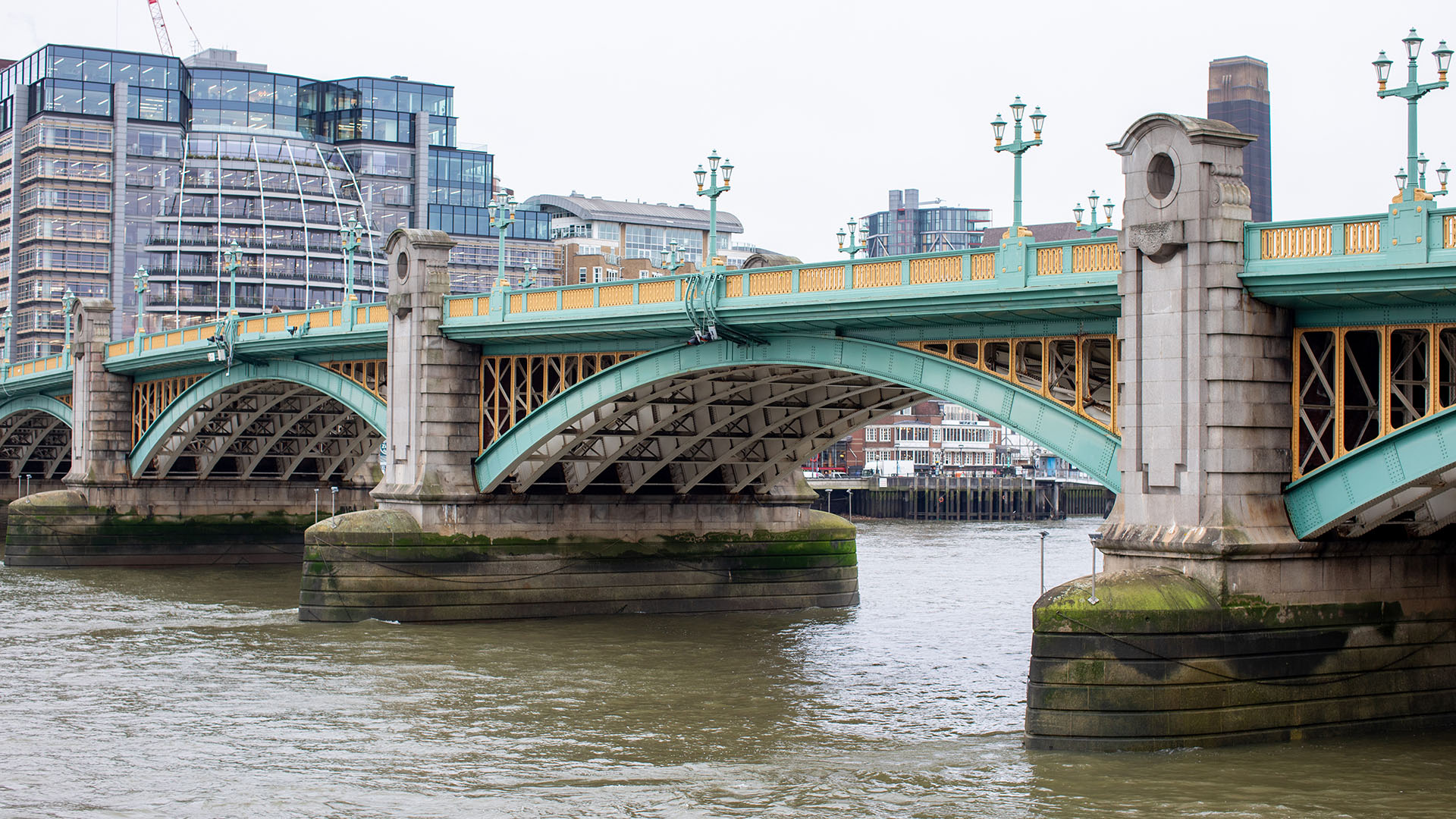
The first bridge on this site was designed by John Rennie and opened in 1819. It was a toll bridge and included one of the largest cast iron arches ever built. However, within 80 years or so it was clear that the bridge was too narrow to cope with an increased amount of traffic and the decision was taken to replace it.
The new bridge was completed in 1921 and was designed to ensure that the piers lined up with those of both Blackfriars and London Bridges to assist navigation. The turrets on the piers were designed by Sir Ernest George RA.
Tower Bridge
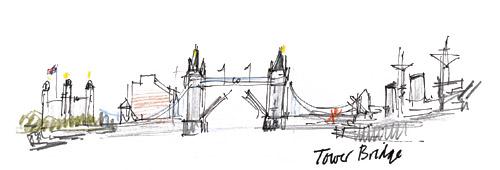
As traffic levels increased in the 19th century it became clear that a new bridge was needed to the east of London Bridge. This bridge would have to allow the passage of tall ships into the Port of London so the City Engineer, Sir Horace Jones, suggested a double-bascule leaf bridge.
Work started in 1886 and the bridge was completed in 1894. Sir Horace Jones died just after work began and the project was completed by Sir John Wolfe Barry with the assistance of Brunel (the younger).
The bridge opened 22 times per day on average during the early years but, as commercial shipping migrated downstream, this frequency reduced. Nowadays it opens on average once a day.
On one occasion, in 1953, a bus was trapped on the roadway and had to leap several feet to the other side - there were no serious injuries.
Twickenham Bridge
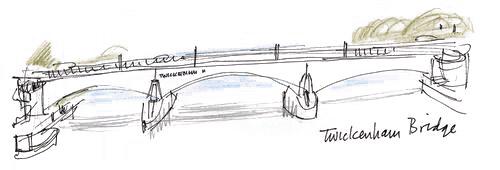
A modern road bridge designed by Maxwell Ayrton and one of three new bridges opened by the Prince of Wales in July 1933.
The bridge has reinforced concrete arches with permanent hinges to allow adjustment for changes in temperature. It was the first bridge incorporating this feature to be built in Britain.
Vauxhall Bridge
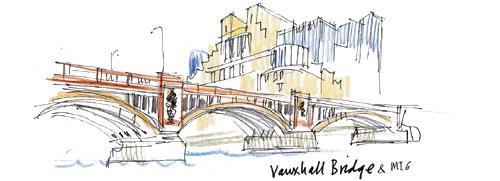
This bridge was designed by Sir Maurice Fitzmaurice and opened in 1906. It replaced an earlier structure built in 1816 to a design by James Walker. Then called Regent's Bridge, this was the first iron bridge to be built on the Thames.
The later name of Vauxhall was derived from Falkes' Hall, a nearby manor house built in the 13th century by Falkes de Breaute, a henchman of King John.
Frederick Pomeroy and Alfred Drury sculpted the bronze figures that adorn the piers on either side of the bridge. These represent the Arts and Sciences, namely Agriculture, Architecture, Engineering, Learning, Education, Astronomy and the Fine Arts.
Wandsworth Bridge
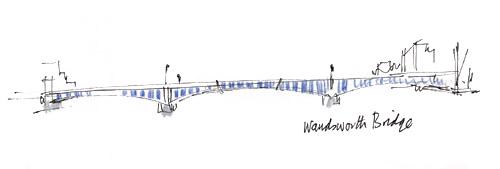
A wrought iron structure designed by Julian Tolmne was built here in 1873. It was of the lattice girder type and had a wooden roadway.
After 60 years or so, this bridge proved unable to cope with increasing levels of traffic so a new bridge was commissioned in 1935. This was designed by Sir Peirson Frank and opened in 1940.
Waterloo Bridge
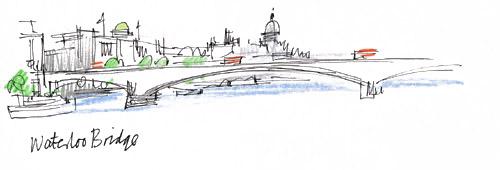
The first bridge on this site was built by John Rennie. Originally known as the Strand Bridge, it was re-named Waterloo Bridge in 1816. It was opened in 1817 by the Prince Regent, accompanied by the Duke of Wellington, on the second anniversary of Wellington's famous victory at the Battle of Waterloo.
By 1923 it was found that the three central piers were sinking and despite efforts to remedy this by reinforcing the foundations, the bridge was closed on safety grounds.
Work began on a replacement bridge to a design by Sir Gilbert Scott in 1937. Built primarily during the Second World War, women became a large part of the construction workforce, leading to the bridge being referred to as "The Ladies Bridge".
This magnificent bridge with five spans, each of 230 feet (70 metres), opened in 1945. It is constructed of reinforced concrete faced with Portland Stone and is the longest bridge in London.
Westminster Bridge
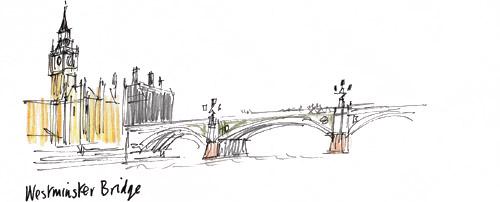
The original bridge completed in 1750 was only the second bridge to cross the Thames in Central London. The next nearest crossing was at Putney, which opened in 1729. The new bridge met much opposition from the watermen, who made their living ferrying people across the river. The bridge featured semi-octagonal turrets at intervals to provide shelter for pedestrians, but they soon became haunts for cut-throats and prostitutes. Twelve nightwatchmen were hired to guard travellers.
The bridge became unsafe and work began in 1854 on a replacement designed by Thomas Page.
The new bridge opened in 1862 and is the oldest bridge in use in Central London.
Discover
